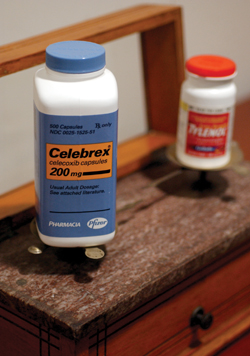
A recent study found that most patients prefer Celebrex to acetaminophen for treating their osteoarthritis pain. Photo by Dana Johnson
Study: No ‘cookie-cutter’ model for pain treatment
When it comes to relieving the pain of osteoarthritis, Celebrex is better than acetaminophen (e.g., Tylenol) for most patients, according to a study led by Theodore Pincus, M.D., professor of Medicine at Vanderbilt University Medical Center.
More than 20 million people in the United States suffer from osteoarthritis, which results from the breakdown of joint cartilage due to injury, aging or other unknown factors. There has been a long-standing debate regarding the best treatment for this condition — non-steroidal anti-inflammatory drugs (NSAIDs) or acetaminophen.
Until the 1990s, NSAIDs, such as ibuprofen (e.g., Advil) and naproxen (e.g., Aleve), were the standard treatment for osteoarthritis pain because they were thought to offer better pain relief than acetaminophen. However, their use was associated with side effects, particularly the dangerous side effect of gastrointestinal bleeding, discovered in large part by Vanderbilt researchers Marie Griffin, M.D., and Wayne Ray, Ph.D.
These concerns led to studies in the early 1990s, which suggested that acetaminophen offered essentially the same pain relief as popular NSAIDs like ibuprofen or naproxen without the risky side effects. The American College of Rheumatology recommended that acetaminophen be given as the initial drug of choice for osteoarthritis pain.
“The clinical trials showing similar effectiveness of acetaminophen and NSAIDs were considered to be supporting evidence that acetaminophen would be as good as an NSAID,” Pincus said. “Some of us thought that this really wasn’t accurate, and the trials had too few subjects.”
Pincus set out to test further the true efficacy of such drugs. The first studies involved surveys of patients treated for osteoarthritis. Pincus and colleagues found that about 80 percent of patients preferred an NSAID to acetaminophen. This survey spawned a larger clinical trial comparing the efficacy of acetaminophen versus the NSAID Arthrotec, where he again found that patients preferred the NSAID.
Since that time, new drugs that specifically inhibit the enzyme cyclooxygenase-2 (COX-2) have been developed. These new drugs are thought to cause fewer gastrointestinal problems than traditional NSAIDs.
With support from the Pfizer Corporation, the maker of the NSAID Celebrex (generic name: celecoxib), Pincus led another study to test osteoarthritis treatment.
Patients involved in the current study were treated with Celebrex, acetaminophen or placebo for six weeks. After a period of three to seven days to clear the first treatment from their systems, patients were given a different treatment than they received in the first part of the study. This complex design allowed Pincus and his colleagues to make all of the different comparisons necessary to evaluate these treatments. And just to be certain, the researchers did it twice.
The study, appearing in the July edition of the Annals of the Rheumatic Diseases, showed that 50 percent to 53 percent of patients with osteoarthritis of the hip or knee preferred Celebrex to acetaminophen, while 20 percent to 32 percent preferred acetaminophen to Celebrex. About 20 percent had no preference.
The results confirmed again what Pincus had proposed all along — that most patients preferred NSAIDs to acetaminophen. However, Pincus cautions that clinical trial data can lead to erroneous assumptions.
According to Pincus, these studies suggest that there is no “cookie-cutter” model for treating osteoarthritis pain. The fact that most patients preferred Celebrex doesn’t mean that all patients with osteoarthritis should be given Celebrex, Pincus said. Although most patients with osteoarthritis of the hip or knee preferred Celebrex, some patients preferred acetaminophen or had no preference.
“The results argue that trying to recommend the same therapy for everyone doesn’t make sense,” he said.
Patient drug preference is like flavors of ice cream, Pincus describes. “Some people think chocolate ice cream is wonderful, but peach ice cream is awful. Others have the opposite inclination. Some would be fine with any flavor,” Pincus said.
One particularly important aspect of this study is the primary outcome measure — patient preference. In other words, the researchers allowed patients to tell them what treatment worked the best for them rather than using lab tests or the researcher’s evaluation of the patients’ pain. This is surprisingly unusual in clinical trials, according to Pincus.
“The goals of our treatment — relief of pain, fatigue, psychological distress – all that information can best be gathered from a patient. I can never estimate someone’s pain as well as the patient,” Pincus said. “Asking patients to decide, especially when you’re treating pain, would seem like a very good approach to this problem.”
In the future, Pincus wants to examine the effect of combining acetaminophen with other pain-relieving drugs since, in the real world, people often take a combination of drugs. Important questions about the effectiveness and safety of doing this have not yet been addressed by clinical research.
There is currently an ongoing study to analyze anakinra, a biological agent, which patients must inject daily for 4-8 weeks, in osteoarthritis. Although daily injections may seem like a very difficult therapy, pain relief may justify such an approach for some patients. Possible subjects are being recruited through 936-2151. “My goal is to make people more comfortable. Pain is a very bad thing — it eats at people, it makes them unhappy, it interferes with thinking straight,” Pincus said. “I’m trying to see what else we can do to help people with their pain.”













